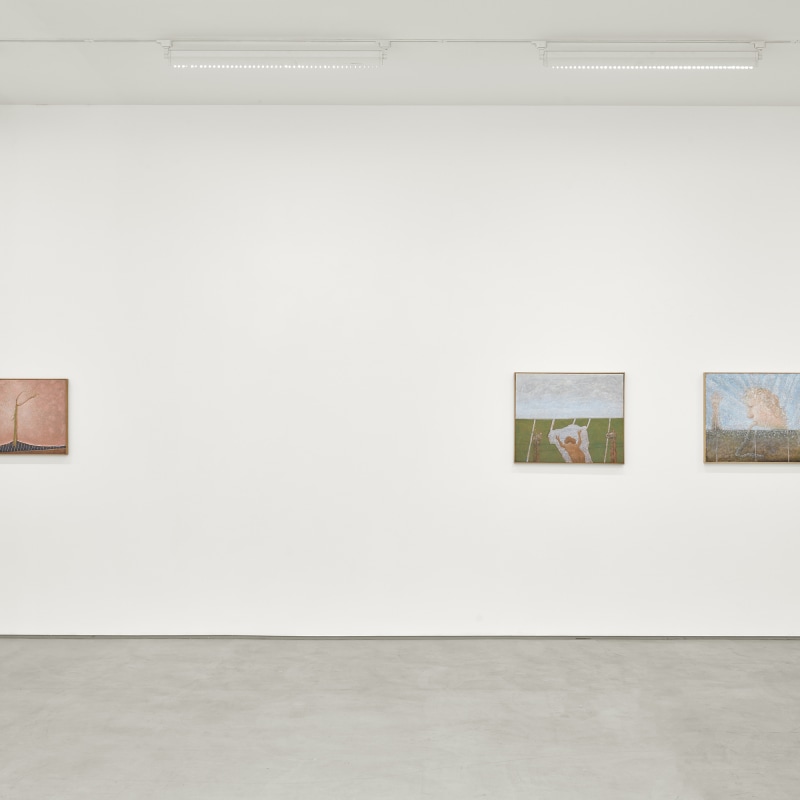From September to November 2019, Sadie Coles HQ will present an exhibition of paintings by the Dutch artist Co Westerik (1924-2018). Concentrating mostly on the last two decades of his life, the forty paintings in the exhibition chart the artist's prolific late phase. The show was inspired by the comprehensive and revelatory retrospective presented at the Museum Boijmans Van Beuningen between February and May this year, curated by Francesco Stocchi.
Westerik's works often began with images from the real world - hands, plants, recumbent bodies, anonymous heads and other everyday subjects that point back to his origins at the Academie van Beeldende, The Hague, from 1945-47, with its emphasis on stylized figuration. Yet the act of painting was a means of probing the inner life and underlying strangeness of ordinary things. Westerik described his process as "an expedition in search of territory deep down". Working slowly and employing a combination of oil paint and tempera, he translated everyday sensations and sights into modern-day emblems.
The views presented are typically close-up and truncated - a wrinkled foot making contact with the ground, for instance, or a man levering back his head to shave beneath his ear. Many of the subjects are depicted against a horizontal conjunction of earth and sky - an open, understated realm. As the artist Cor Blok has observed: "The people in Westerik's paintings have no history, or, if they are involved in an event, indications of what went before or what may come after are restricted to a minimum." The image of one hand grasping another recurs in several works dating between 1984 and 2015. In these and many other canvases, Westerik centralized the concept of touch.
Westerik's works resemble frescoes in their execution - he usually applied paint in smooth, thin, partially transparent layers. And yet they achieve an iridescent realism that crosses into the surreal or symbolist. Flesh is repeatedly the focus of that transition from the palpable to the otherworldly - in its variegated textures, its capacity to age or distend, or its ability to symbolize emotional or psychological states. Often, the scale of the body is indeterminate. The encroaching hand in Main sur terre (2017) suggests a geologic formation surrounded by Lilliputian trunks and stumps, while Woman on bed (1994) reimagines the female nude as a landscape of flattened, smooth-contoured shapes filled with dappled flesh-tone.
Westerik’s work invokes the long tradition of Dutch realism and still life, but his outlook was also avowedly modern and international. In 1964, he was included in the ‘New Realists’ exhibition curated by Wim Beeren at the Gemeentemuseum, alongside figures including Francis Bacon, David Hockney, Yves Klein, Edoardo Paolozzi and Claes Oldenburg, an exhibition that reflected his affinity with (and participation in) wider experiments in figuration in the post-war decades. Yet the assimilation of Pop Art by certain of his Dutch contemporaries was not shared by Westerik. This survey of his last forty years bears witness to the singularity of his oeuvre, above all in its conflation of the realist and quixotic. Repeatedly, despite their acute sensitivity to the outward forms and textures of things, Westerik’s paintings communicate what he described as “a state of mind, averse to any decorative intent.”
Co Westerik (b. 1924, The Hague, d. 2018) studied at the Academie van Beeldende, the Hague, graduating in 1947. From 1958 to 1971 he worked as a teacher of life drawing at the academy. From 1971, he worked from Rotterdam and the south of France. His oeuvre spans painting, drawing and etching. In 1999 he was made a Knight of the Order of the Netherlands Lion. This exhibition features paintings and some drawings deriving primarily from the collection of the artist himself, as well as from private collections in the Netherlands. Boijmans Van Beuningen, Rotterdam, the Gemeentemuseum in The Hague, and the Stedelijk Museum in Amsterdam all hold important collections of Westerik’s work.
